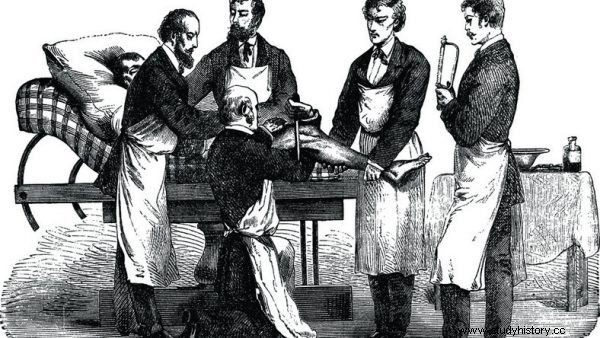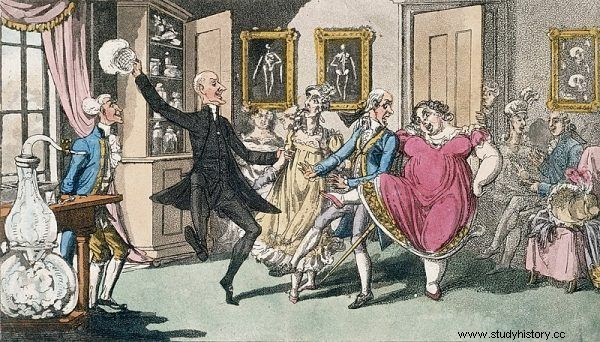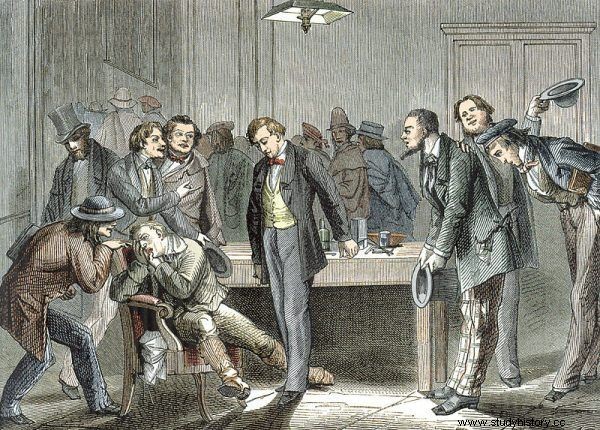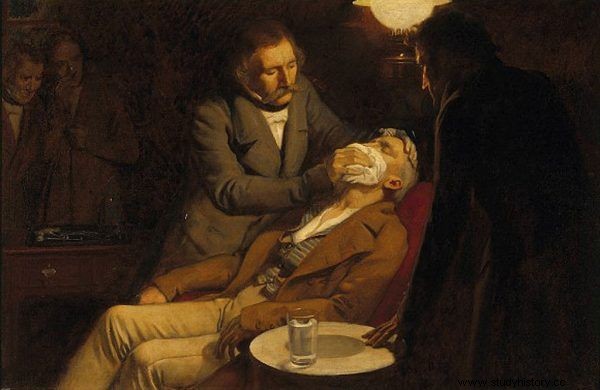What did small-town games, the Indians, the dentist, and the escape from the operating table have in common? The discovery of anesthesia in medicine took some time and unsuccessful experiments.
Nowadays it is difficult to imagine life without painkillers and anesthesia. Before anesthesia was used in medicine, however, people dealt with pain in different ways. Most often it was alcohol or opium. To reduce the sensitivity, local pressure or ice packs were also used. However, it cannot be denied that for a long time all surgical procedures were terrifyingly painful and doctors simply tied patients to chairs.
The average surgeon looked more like a butcher back then - until the beginning of the 19th century his outfit was stained, even stiff with blood . The operating table was, in fact, an ordinary red cloth upholstered chair to which the patient was tied. For this purpose, a strong cord was used, which in turn was tied around the pillars in the operating room. Additional staff were nurses whose main task was to restrain the patient. Doctors performed their procedures as quickly as possible to spare people suffering. Apparently Robert Liston performed an amputation of a lower leg in…. 26 seconds!

Before the discovery of anesthesia, doctors performed the procedures in the shortest possible time
Laughing Gas, Colt and Indians
The introduction of anesthesia to medicine has some very interesting beginnings. Several American entrepreneurs organized specific performances in small towns for profit. Volunteers were invited to the stage and administered nitrous oxide, commonly known as laughing gas . To the delight of the audience, the volunteers acted as if they were under the influence of alcohol - they laughed and staggered, they were in euphoric moods.
One of the organizers of this type of venture was Samuel Colt, who raised funds to patent his revolver . His performance, however, turned out to be a "flop", because the gas was given to the Indians who just ... fell asleep . Today we know that they were much less tolerant to this type of substances. At that time, no one had drawn any conclusions from it yet.

Probably no one thought that simple entertainment would become one of the most important discoveries in medicine!
Escape from the operating table
a young dentist - Horacy Wells participated in a similar event . His friend decided to take nitrous oxide on stage, and during the "performance" he did not even notice that he had badly injured his leg by a protruding nail. Fascinated by this, Wells entered the stage himself and repeated the experiment. Apparently he was supposed to say later:
I think you can have a tooth extracted or a leg amputated without pain if you inhale the gas ...

Although the first anesthetic surgery proved to be a disaster, changes in medicine were inevitable
The next day he decided to test the effects of the substance in his office. Under the influence of nitrous oxide, the assistant removed his wisdom tooth. Delighted, Wells concluded:
I didn't feel anything more than a minor sting - it is the most wonderful discovery of our time.
After consulting a chemist who pointed out that ether also has very similar properties, Wells decided to present the results of the research to a wider audience. On January 17, 1845, ether surgery was performed under the skeptical eye of Dr. John Warren at Massachusetts General Hospital. Unfortunately, Wells either used the wrong dose or started the procedure too early, for the moment he started the extraction, the terrified patient jumped up from the table. It brought a lot of joy to the students watching the stage. Wells' patient was an obese alcoholic - Wells was unaware at the time that these factors would reduce the effects of anesthesia. The demonstration procedure ended in complete embarrassment.
Fortunately for the advancement of medicine, research was continued by William Morton Wells friend. After several attempts, he returned to Dr. Warren and finally, on October 16, 1846, he successfully removed the mandibular tumor while fully dormant . This date has become a real milestone in the history of medicine.
The introduction of general anesthesia, or simply sleep, revolutionized surgery.

Treatment with the use of ether
You will give birth in pain
The invention was also introduced during childbirth. The Anglican clergy, however, were not delighted with the use of the ether, according to the Old Testament quote: In pain you will give birth . A gigantic discussion about the use of anesthesia in medicine broke out. At the same time, the ether became more and more popular, as it turned out that the anesthetic herself underwent ... Queen Victoria . This is how her son, Leopold, was born. From that moment on, women - of course the richer and higher class - demanded delivery under anesthesia.
Although the road to widespread introduction of anesthesiology was still quite long and quite complicated (just mention the conflicts over Wells' authorship and suicide!), Nevertheless the medical world had already taken its first steps.
